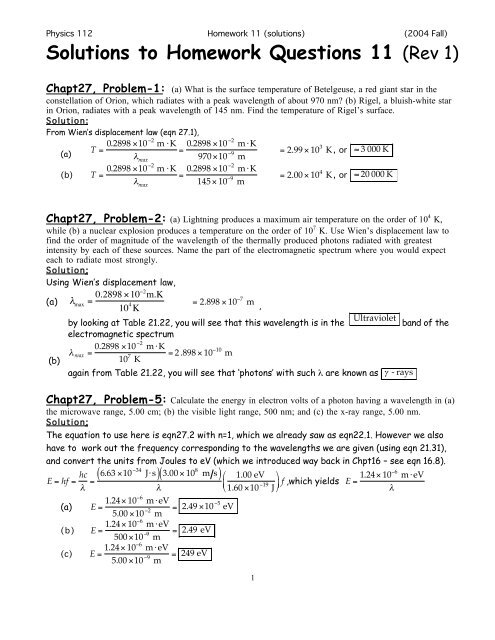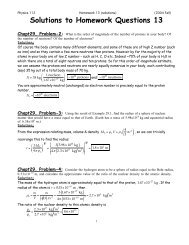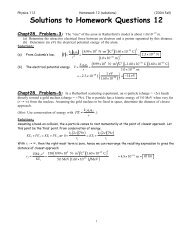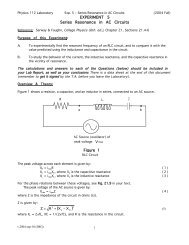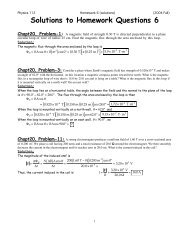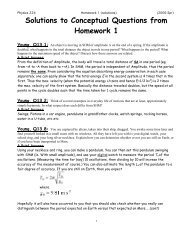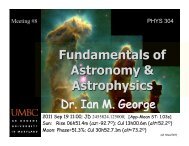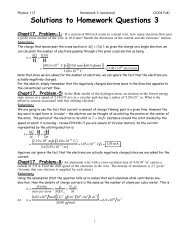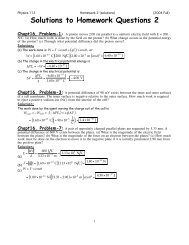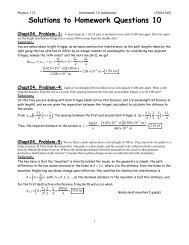Solutions to Homework Questions 11 (Rev 1)
Solutions to Homework Questions 11 (Rev 1)
Solutions to Homework Questions 11 (Rev 1)
You also want an ePaper? Increase the reach of your titles
YUMPU automatically turns print PDFs into web optimized ePapers that Google loves.
Physics <strong>11</strong>2 <strong>Homework</strong> <strong>11</strong> (solutions) (2004 Fall)<br />
<strong>Solutions</strong> <strong>to</strong> <strong>Homework</strong> <strong>Questions</strong> <strong>11</strong> (<strong>Rev</strong> 1)<br />
Chapt27, Problem-1: (a) What is the surface temperature of Betelgeuse, a red giant star in the<br />
constellation of Orion, which radiates with a peak wavelength of about 970 nm? (b) Rigel, a bluish-white star<br />
in Orion, radiates with a peak wavelength of 145 nm. Find the temperature of Rigel’s surface.<br />
Solution:<br />
From Wien’s displacement law (eqn 27.1),<br />
(a)<br />
(b)<br />
T = 0.2898 !10 "2 m #K<br />
$ max<br />
T = 0.2898 !10 "2 m #K<br />
$ max<br />
= 0.2898 !10 "2 m #K<br />
970 !10 "9 m = 2.99 ! 103 K , or ! 3 000 K<br />
= 0.2898 !10 "2 m #K<br />
145 ! 10 "9 m = 2.00 ! 104 K , or ! 20 000 K<br />
Chapt27, Problem-2: (a) Lightning produces a maximum air temperature on the order of 10 4 K,<br />
while (b) a nuclear explosion produces a temperature on the order of 10 7 K. Use Wien’s displacement law <strong>to</strong><br />
find the order of magnitude of the wavelength of the thermally produced pho<strong>to</strong>ns radiated with greatest<br />
intensity by each of these sources. Name the part of the electromagnetic spectrum where you would expect<br />
each <strong>to</strong> radiate most strongly.<br />
Solution:<br />
Using Wien’s displacement law,<br />
(a) ! max = 0.2898 "10#2 m.K<br />
10 4 K = 2.898 ! 10"7 m ,<br />
(b)<br />
by looking at Table 21.22, you will see that this wavelength is in the Ultraviolet band of the<br />
electromagnetic spectrum<br />
! max = 0.2898 "10 #2 m $K<br />
10 7 = 2 .898 " 10<br />
K<br />
#10 m<br />
again from Table 21.22, you will see that ‘pho<strong>to</strong>ns’ with such ! are known as ! - rays<br />
Chapt27, Problem-5: Calculate the energy in electron volts of a pho<strong>to</strong>n having a wavelength in (a)<br />
the microwave range, 5.00 cm; (b) the visible light range, 500 nm; and (c) the x-ray range, 5.00 nm.<br />
Solution:<br />
The equation <strong>to</strong> use here is eqn27.2 with n=1, which we already saw as eqn22.1. However we also<br />
have <strong>to</strong> work out the frequency corresponding <strong>to</strong> the wavelengths we are given (using eqn 21.31),<br />
and convert the units from Joules <strong>to</strong> eV (which we introduced way back in Chpt16 – see eqn 16.8).<br />
E = hf = hc<br />
! = 6.63 "10 #34 ( J$s ) 3.00 " 10 8 ( ms)<br />
1.00 eV<br />
!<br />
1.60 "10 #19 %<br />
(<br />
'<br />
* f ,which yields E =<br />
&<br />
J )<br />
1.24! 10"6 m #eV<br />
$<br />
(a)<br />
(b)<br />
(c)<br />
E = 1.24! 10"6 m #eV<br />
5.00 !10 "2 m = 2.49 !10 "5 eV<br />
E = 1.24! 10"6 m #eV<br />
500 !10 "9 = 2.49 eV<br />
m<br />
E = 1.24! 10"6 m #eV<br />
5.00 !10 "9 = 249 eV<br />
m<br />
1
Physics <strong>11</strong>2 <strong>Homework</strong> <strong>11</strong> (solutions) (2004 Fall)<br />
Chapt27, Problem-8: The threshold of dark-adapted (sco<strong>to</strong>pic) vision is 4.0x10 –<strong>11</strong> W/m 2 at a<br />
central wavelength of 500 nm. If light with this intensity and wavelength enters the eye when the pupil is<br />
open <strong>to</strong> its maximum diameter of 8.5 mm, how many pho<strong>to</strong>ns per second enter the eye?<br />
Solution:<br />
Here we are given the power per unit area of the light entering the eye (in the case where that faint<br />
light is only just detectable by the cones). We are given the diameter of the pupil, so we can work<br />
out its area, and hence calculate the <strong>to</strong>tal power of the light entering the eye. [Note that the radius<br />
is D/2, for ! r 2 = (! D 2 )/4]. So this is<br />
( ) %<br />
( ) 2<br />
&<br />
!= I "A = 4.0 # 10 $<strong>11</strong> Wm 2<br />
4 8.5 # 10$3 )<br />
(<br />
m +<br />
'<br />
*<br />
= 2.3 #10 $15 W<br />
Now the power is given in Watts (Joules per second), so if we calculate the energy of each pho<strong>to</strong>n<br />
(in Joules), we can easily calculate the number of pho<strong>to</strong>ns…<br />
The energy of a single pho<strong>to</strong>n is<br />
E ! = hc<br />
" = 6.63 #10 $34 ( J%s ) 3.00 # 10 8 ( ms)<br />
500 # 10 $9 = 3.98 #10<br />
m<br />
$19 J ,<br />
so the number of pho<strong>to</strong>ns entering the eye in !t = 1.00 s is<br />
N = !E<br />
=<br />
E "<br />
#$ !t ( )<br />
=<br />
E "<br />
2.3% 10-15 ( Js)1.00<br />
( s)<br />
3.98 % 10 &19 = 5.7 !10<br />
J<br />
3<br />
Chapt27, Problem-20: Calculate the minimum wavelength x-ray that can be produced when a<br />
target is struck by an electron that has been accelerated through a potential difference of (a) 15.0 kV, (b) 100<br />
kV.<br />
Solution:<br />
A pho<strong>to</strong>n of maximum energy and minimum wavelength is produced when the electron gives up all its<br />
kinetic energy in a single collision. (see eqn27.9)<br />
! min =<br />
(a)<br />
( ) 3.00# 10 8 ( ms)<br />
hc<br />
=<br />
( E " ) max<br />
hc<br />
eV = 6.63 #10 $34 J%s<br />
1.60 #10 -19 ( C)V<br />
If<br />
( b ) If<br />
V = 15.0 kV ,<br />
V = 100 kV ,<br />
2<br />
= 1.24 # 10$6 V% m<br />
V<br />
! min = 1.24 "10 #6 V $m<br />
15.0 "10 3 V = 8.29! 10"<strong>11</strong> m<br />
! min = 1.24 "10 #6 V $m<br />
100 " 10 3 V = 1.24! 10"<strong>11</strong> m<br />
Chapt27, Problem-25: X-rays of wavelength 0.140 nm are reflected from a certain crystal, and the<br />
first-order maximum occurs at an angle of 14.4°. What value does this give for the interplanar spacing of this<br />
crystal?<br />
Solution:<br />
The interplanar spacing in the crystal is given by Bragg’s law (eqn 27.10, with m=1) as<br />
d = m! ()0.140 1 ( nm )<br />
= = 0.281 nm<br />
2sin" 2sin14.4°
Physics <strong>11</strong>2 <strong>Homework</strong> <strong>11</strong> (solutions) (2004 Fall)<br />
Chapt27, Problem-28: A beam of 0.68-nm pho<strong>to</strong>ns undergoes Comp<strong>to</strong>n scattering from free<br />
electrons. What are the energy and momentum of the pho<strong>to</strong>ns that emerge at a 45° angle with respect <strong>to</strong> the<br />
incident beam?<br />
Solution:<br />
Using the Comp<strong>to</strong>n shift formula, (eqn27.<strong>11</strong>) the wavelength is found <strong>to</strong> be<br />
! = ! 0 + "! = ! 0 + ! C( 1# cos $ )<br />
= 0.68 nm + ( 0.00243 nm ) ( 1# cos 45° )= 0.6807 nm<br />
Therefore the energy of the pho<strong>to</strong>n (see eqn27.12) is<br />
E ! = hc<br />
" = 6.63 #10 $34 ( J %s)<br />
3.00# 10 8 ( ms)<br />
0.6807 #10 $9 1 keV<br />
m 1.60 # 10 $16 &<br />
)<br />
(<br />
+ = 1.8 keV ,<br />
'<br />
J *<br />
and the momentum (eqn 27.13) is<br />
h<br />
p =<br />
! = 6.63 "10 #34 J$s<br />
0.6807 "10 #9 m = 9.7 ! 10"25 kg #m s<br />
Chapt27, Problem-34: Calculate the de Broglie wavelength for an electron that has kinetic energy<br />
(a) 50.0 eV and (b) 50.0 keV (ignore relativistic effects).<br />
Solution:<br />
The de Broglie wavelength is ! = hp, where p is the linear momentum. If relativistic effects are<br />
ignored, then one can easily relate the momentum p=mv <strong>to</strong> KE=(mv 2 )/2 so<br />
(a) If<br />
3<br />
( )<br />
p = 2 mKE<br />
KE= 50.0 eV and the particle is an electron,<br />
6.63 "10<br />
! =<br />
#34 J$s<br />
2 9.<strong>11</strong>" 10 #31 ( kg)<br />
( 50.0 eV)<br />
1.60 "10 #19 = 1.74 !10<br />
( JeV)<br />
"10 m = 0.174 nm<br />
(b) For 50.0 keV electrons,<br />
! =<br />
2 9.<strong>11</strong>" 10 #31 ( kg)<br />
50.0 "10 3 eV<br />
6.63 "10 #34 J $s<br />
( ) 1.60" 10 #19 ( JeV)<br />
= 5.49 !10 "12 m<br />
Chapt27, Problem-42: A 50.0-g ball moves at 30.0 m/s. If its speed is measured <strong>to</strong> an accuracy of<br />
0.10%, what is the minimum uncertainty in its position?<br />
Solution:<br />
For this question, the eqn27.16 is relevant. We are given the information <strong>to</strong> calculate the momentum<br />
p = mv , and so !p = m !v ( ) assuming m is without uncertainty. Since !v = 1.0 "10 #3 v = 3.0 " 10 #2 ms,<br />
we have<br />
!p = 50.0 " 10#3 ( kg)<br />
3.0 "10 #2 ( ms)=<br />
1.5 "10 #3 kg $m s,<br />
h<br />
and !x "<br />
4# ( !p)<br />
=<br />
6.63 $ 10 %34 J &s<br />
4# 1.5 $10 %3 ( kg &m s)<br />
= 3.5 !10 "32 m<br />
Chapt27, Conceptual-3: Are blackbodies black?<br />
Solution:<br />
(see explanation in text)
Physics <strong>11</strong>2 <strong>Homework</strong> <strong>11</strong> (solutions) (2004 Fall)<br />
Chapt27, Conceptual-5: All objects radiate energy. Why, then, are we not able see all objects in a<br />
dark room?<br />
Solution:<br />
(see explanation in text)<br />
Chapt27, Conceptual-10: Which has more energy, a pho<strong>to</strong>n of ultraviolet radiation or a pho<strong>to</strong>n<br />
of yellow light?<br />
Solution:<br />
Ultraviolet light has a shorter wavelength and a higher frequency (so pho<strong>to</strong>n energy) than visible<br />
light – see Table21.22).<br />
Chapt27, Conceptual-14: The brightest star in the constellation Lyra is the bluish star Vega,<br />
whereas the brightest star in Bootes is the reddish star Arcturus. How do you account for the difference in<br />
color of the two stars?<br />
Solution:<br />
Most stars radiate nearly as blackbodies. Vega has a higher surface temperature than Arcturus. So<br />
Vega radiates more intensely at shorter wavelengths (i.e. in the ‘blue’ end of the visible spectrum).<br />
In contrast Arcturus, with its cooler surface, radiates more intensely at longer wavelengths (i.e.<br />
<strong>to</strong>wards the ‘red’ end of the visible band).<br />
4


